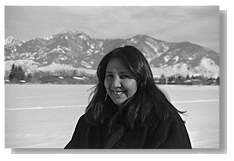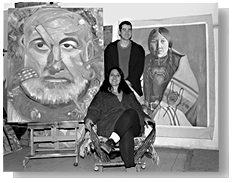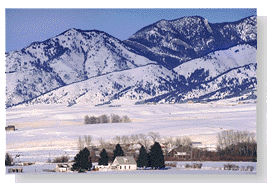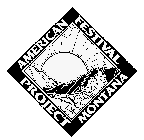|
From the Circle of Thunder
My earliest memories of the Pow Wow come from my father, who had been relocated by the Government to California for a job. That's where I was born, along with four of my siblings. My father would take us on trips to the country to camp. He loved to be outdoors. He would sit me down and say "ee da gaa" (Look way over there, that's where I am from). I remember how homesick he was for his family back in the high plains of Montana. He was Crow, a proud man with strong ties to his people (also known as the Absoolakals). Every year he would take his vacation and travel back to his Crow friends and relatives. He would never let us forget where we came from. When we crossed the border into Montana I could almost hear him sigh as he felt very much as if he was home. What I remember most in those days was how he used to sit for hours almost as if he were somewhere far off keeping beat to some rhythm in his head and whistling some song from his past. His hand would tap out the rhythm of a song he was singing in his mind. I would crawl up into his lap to sit and listen to these songs. I wanted to be inside his mind and see what he saw. Oftentimes I would ask him to speak Crow to me. The sounds of the language would somehow comfort and make me feel safe from a world that I felt was all too foreign. So as a child I found those journeys back to the "Res" emotionally invigorating for my spirit. When he would speak Crow to me, I felt close to him and knew I was protected by a loving father who wanted so much to give me the best of both worlds. Some nights he would sing songs, Pow Wow songs, and tell me to dance, or he would put on a tape (reel to reel I might add) of his singing in a drum group that he had recorded from previous Crow Fairs. It only took me a second and I was up and dancing to my heart's content. This was truly his gift to me. My fondest memories were of my aunts dressing me up in fine buckskin dress and moccasins. Everything had a right way of being done, from the way the moccasins had to be tied, to the way our hair was braided. For example, the hair had to be braided with a certain precision, not too far forward or too far back, but near the ear lobe where it looked best. It must be tight but not too tight. They would tell me these things as they combed my hair. The red markings on my face were drawn near my temples next to the eyes, like a chevron mark fanning outward. I remember how my Auntie Mayme would tie my moccasins. She stood in front of me as I sat, picking up my leg and placing my heel on her thigh. She had me hold my foot pointing my toe up to the sky, flexing the calf muscle. Then she wrapped the buckskin thong around my ankle and tucked it back into itself behind the ankle. She would ask me to stand and see if it was too tight, but it was almost always perfect. She would nod her head and say, "good", and proceed with the other foot in silence, slowly and deliberately. My Uncle Toots was a little skeptical of my competence and had cajoled my cousins into giving me a few tips before we arrived. Needless to say I took to it like a teal to a stream. I recall my Uncle's astonished eyes as I whirled around the Arbor leaving my cousins in the dust. My father always thought of me as his baby Indian girl. I never stopped asking questions about the world from which he came and knew in my heart this was my world. Years later as I traveled those same highways I came to realize how my father must have felt, going back to the land of his beginnings, into Crow country, and knew I had come home this time for good. The culture is alive, growing and evolving. This survival is the miracle that I witness when I participate at the Pow Wows. We were once viewed as a dying race but we are not beaten, we are a thriving people. The celebration becomes a symbol of that survival, and it is this cultural experience that sustains my belief. |
||||||||||||||||||
| Montana Indian Contemporary Arts
MICA serves as an information center and dissemination point for all media of the fine arts. This work includes curating exhibits, developing literary publications and symposia, presenting performances and dances and assisting rural tribal communities in developing strategies for implementing arts programming in their areas. |
||||||||||||||||||
| The Montana American Festival Project
Over the course of the project's three years, these partners have worked together to create a dynamic cultural exchange which has grown from the ground up, shaped by each community's unique experience, vision and long term goals. The exchange has included not only performances and workshops by both Montana and national touring artists, but the organization in most communities of story circles that have collected personal/local stories and begun to share them through performances by community members. Through its exploration of oral traditions, and the collection and sharing of stories, the Montana American Festival Project is validating the richness, strength and cultures of each of the participating communities; helping people to better appreciate each other's cultural heritage and Montana's diverse culture; inspiring the further telling, collecting and sharing of stories; and providing venues for discussion and analysis of community issues. |
||||||||||||||||||
| Published in In Motion Magazine November 30, 1995 |
||||||||||||||||||
If you have any thoughts on this or would like to contribute to an ongoing discussion in the  What is New? || Affirmative Action || Art Changes || Autonomy: Chiapas - California || Community Images || Education Rights || E-mail, Opinions and Discussion || En español || Essays from Ireland || Global Eyes || Healthcare || Human Rights/Civil Rights || Piri Thomas || Photo of the Week || QA: Interviews || Region || Rural America || Search || Donate || To be notified of new articles || Survey || In Motion Magazine's Store || In Motion Magazine Staff || In Unity Book of Photos || Links Around The World NPC Productions Copyright © 1995-2020 NPC Productions as a compilation. All Rights Reserved. |





 Since 1989, Montana Indian Contemporary Arts (MICA) has functioned as an educational and service organization, promoting and providing leadership for contemporary Indian artists in Montana and the Northwest region of the United States. MICA strives to develop a network of support for Native artists who are innovative and on the leading edge of contemporary American Indian art expression. It networks with many national organizations, as well as many of the reservation communities, bringing the Native voice to a national level.
Since 1989, Montana Indian Contemporary Arts (MICA) has functioned as an educational and service organization, promoting and providing leadership for contemporary Indian artists in Montana and the Northwest region of the United States. MICA strives to develop a network of support for Native artists who are innovative and on the leading edge of contemporary American Indian art expression. It networks with many national organizations, as well as many of the reservation communities, bringing the Native voice to a national level. The Montana American Festival Project is a multi-year (1992-1995) collaborative project involving Montana cultural organizations, community partners and artists, along with national touring artists and the
The Montana American Festival Project is a multi-year (1992-1995) collaborative project involving Montana cultural organizations, community partners and artists, along with national touring artists and the